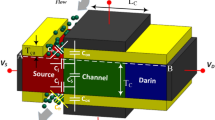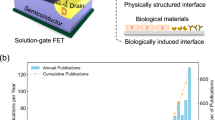Abstract
Interest in biosensors based on field-effect transistors (FETs), where an electrically operated gate controls the flow of charge through a semiconducting channel, is driven by the prospect of integrating biodetection capabilities into existing semiconductor technology1. In a number of proposed FET biosensors, surface interactions with biomolecules in solution affect the operation of the gate or the channel2,3,4,5,6,7,8,9,10,11,12,13,14,15,16,17,18,19. However, these devices often have limited sensitivity. We show here that a FET biosensor with a vertical gap is sensitive to the specific binding of streptavidin to biotin. The binding of the streptavidin changes the dielectric constant (and capacitance) of the gate, resulting in a large shift in the threshold voltage for operating the FET. The vertical gap is fabricated using simple thin-film deposition and wet-etching techniques. This may be an advantage over planar nanogap FETs, which require lithographic processing20,21,22,23,24. We believe that the dielectric-modulated FET (DMFET) provides a useful approach towards biomolecular detection that could be extended to a number of other systems.
This is a preview of subscription content, access via your institution
Access options
Subscribe to this journal
Receive 12 print issues and online access
$259.00 per year
only $21.58 per issue
Buy this article
- Purchase on Springer Link
- Instant access to full article PDF
Prices may be subject to local taxes which are calculated during checkout




Similar content being viewed by others
References
Kim, D. S. et al. An extended gate FET-based biosensor integrated with a Si microfluidic channel for detection of protein complexes. Sens. Actuator B 117, 488–494 (2006).
Purushothaman, S., Toumazou, C. & Ou, C. P. Protons and single nucleotide polymorphism detection: A simple use for the ion sensitive field effect transistor. Sens. Actuator B 114, 964–968 (2006).
Shekhawat, G., Tark, S. H. & Dravid, V. P. MOSFET-embedded microcantilevers for measuring deflection in biomolecular sensors. Science 311, 1592–1595 (2006).
Wang, W. U., Chen, C., Lin, K. H., Fang, Y. & Lieber, C. M. Label-free detection of small-molecule–protein interactions by using nanowire nanosensors. Proc. Natl Acad. Sci. USA 102, 3208–3212 (2005).
Xiang, J. et al. Ge/Si nanowire heterostructures as high-performance field-effect transistors. Nature 441, 489–493 (2006).
Cui, Y., Wei, Q. Q., Park, H. K. & Lieber, C. M. Nanowire nanosensors for highly sensitive and selective detection of biological and chemical species. Science 293, 1289–1292 (2001).
Patolsky, F. et al. Electrical detection of single viruses. Proc. Natl Acad. Sci. USA 101, 14017–14022 (2004).
Li, C. et al. Chemical gating of In2O3 nanowires by organic and biomolecules. Appl. Phys. Lett. 83, 4014–4016 (2003).
Bradley, K., Cumings, J., Star, A., Gabriel, J. C. P. & Grüner, G. Influence of mobile ions on nanotube based FET devices. Nano Lett. 3, 639–641 (2003).
Star, A. et al. Label-free detection of DNA hybridization using carbon nanotube network field-effect transistors. Proc. Natl Acad. Sci. USA 103, 921–926 (2006).
Star, A., Gabriel, J. C. P., Bradley, K. & Grüner, G. Electronic detection of specific protein binding using nanotube FET devices. Nano Lett. 3, 459–463 (2003).
Star, A., Han, T. R., Gabriel, J. C. P., Bradley, K. & Grüner, G. Interaction of aromatic compounds with carbon nanotubes: correlation to the Hammett parameter of the substituent and measured carbon nanotube FET response. Nano Lett. 3, 1421–1423 (2003).
Star, A., Han, T. R., Joshi, V., Gabriel, J. C. P. & Grüner, G. Nanoelectronic carbon dioxide sensors. Adv. Mater. 16, 2049–2052 (2004).
Javey, A., Guo, J., Wang, Q., Lundstrom, M. & Dai, H. J. Ballistic carbon nanotube field-effect transistors. Nature 424, 654–657 (2003).
Keren, K., Berman, R. S., Buchstab, E., Sivan, U. & Braun, E. DNA-templated carbon nanotube field-effect transistor. Science 302, 1380–1383 (2003).
Stutzmann, N., Friend, R. H. & Sirringhaus, H. Self-aligned, vertical-channel, polymer field-effect transistors. Science 299, 1881–1884 (2003).
Naber, R. C. G. et al. High-performance solution-processed polymer ferroelectric field-effect transistors. Nature Mater. 4, 243–248 (2005).
Muccini, M. A bright future for organic field-effect transistors. Nature Mater. 5, 605–613 (2006).
Oprea, A. et al. Copper phthalocyanine suspended gate field effect transistors for NO2 detection. Sens. Actuator B 118, 249–254 (2006).
Krahne, R. et al. Nanoparticles and nanogaps: controlled positioning and fabrication. Physica E 17, 498–502 (2003).
Iqbal, S. M., Balasundaram, G., Ghosh, S., Bergstrom, D. E. & Bashir, R. Direct current electrical characterization of ds-DNA in nanogap junctions. Appl. Phys. Lett. 86, 153901–153903 (2005).
Ionescu-Zanetti, C., Nevill, J. T., Carlo, D. D., Jeong, K. H. & Lee, L. P. Nanogap capacitors: Sensitivity to sample permittivity changes. J. Appl. Phys. 99, 024305–024309 (2006).
Lazzarino, M. et al. Twin cantilevers with a nanogap for single molecule experimentation. Microelectron. Eng. 83, 1309–1311 (2006).
Yi, M. Q., Jeong, K. H. & Lee, L. P. Theoretical and experimental study towards a nanogap dielectric biosensor. Biosens. Bioelectron. 20, 1320–1326 (2005).
ATLAS v2002 User's Manual (Silvaco, Santa Clara, California, 2006).
Chen, C. D., Cheng, S. F., Chau, L. K. & Wang, C. R. C. Sensing capability of the localized surface plasmon resonance of gold nanorods. Biosens. Bioelectron. 22, 926–932 (2007).
Jang, D. Y. et al. Sub-lithographic vertical gold nanogap for label free electrical detection of protein–ligand binding. J. Vac. Sci. Technol. B 25, 443–447 (2007).
Holmberg, A. et al. The biotin–streptavidin interaction can be reversibly broken using water at elevated temperatures. Electrophoresis 26, 501–510 (2005).
Poghossian, A., Cherstvy, A., Ingebrandt, S., Offenhäusser, A. & Schöning, M. J. Possibilities and limitations of label-free detection of DNA hybridization with field-effect-based devices. Sens. Actuator B 111–112, 470–480 (2005).
Tabata, O., Asahi, R., Funabashi, H., Shimaoka, K. & Sugiyama, S. Anisotropic etching of silicon in TMAH solutions. Sens. Actuator A 34, 51–57 (1992).
Acknowledgements
This work was supported by the National Research and Development Program (NRDP, 2005-01274) for biomedical function monitoring biosensor development sponsored by the Korea Ministry of Science and Technology (MOST). X.J.H. would like to express appreciation for the financial support of the Brain Korea 21 project, the School of Information Technology, and the Korea Advanced Institute of Science and Technology in 2007. The work was partially supported by the Center for Ultramicrochemical Process Systems, sponsored by KOSEF and Samsung Electronics.
Author information
Authors and Affiliations
Contributions
Y.K.C. conceived the biosensor application with a dielectric-modulated field-effect transistor. H.I. and Y.K.C. designed the transistor experiments, and H.I. fabricated the transistors. X.J.H. and H.I. performed bio-related experiments, and B.G. worked on simulation. H.I. and X.J.H. co-wrote the paper. All authors contributed data analysis and interpretation equally.
Corresponding author
Ethics declarations
Competing interests
The authors declare no competing financial interests.
Supplementary information
Supplementary Information
Supplementary figures S1–S3 (PDF 260 kb)
Rights and permissions
About this article
Cite this article
Im, H., Huang, XJ., Gu, B. et al. A dielectric-modulated field-effect transistor for biosensing. Nature Nanotech 2, 430–434 (2007). https://doi.org/10.1038/nnano.2007.180
Received:
Accepted:
Published:
Issue Date:
DOI: https://doi.org/10.1038/nnano.2007.180
This article is cited by
-
Fringe-fields-modulated double-gate tunnel-FET biosensor
Scientific Reports (2024)
-
Design of a label-free biosensor based on dielectrically modulated GeSn heterojunction vertical TFET
Journal of Materials Science: Materials in Electronics (2024)
-
An Improved Z-Shaped Dual-Material-Gate DM-SDZ-TFET Biosensor for Label-Free Detection
Journal of Electronic Materials (2024)
-
Exploring the Potential of Dielectric Modulated SOI Junctionless FinFETs for Label-Free Biosensing
Journal of Electronic Materials (2024)
-
Spacer-Engineered Reconfigurable Silicon Nanowire Schottky Barrier Transistor as a Label-Free Biosensor
Silicon (2024)



